
When you think of colorful and captivating birds, bee-eaters might not be the first that comes to mind. But these birds are a feast for the eyes and a wonder of nature. Imagine a small, lively creature, dressed in vibrant greens, blues, and yellows, darting through the air with the grace of a skilled performer. That’s a bee-eater for you!
These charming birds belong to the Meropidae family, and there’s a lot more to them than their impressive looks. Found in warm, sunny regions from Africa to Asia and Europe, bee-eaters have amazing adaptations that help them thrive in their environments. They are excellent fliers, and their diets are quite fascinating too—mostly feeding on insects, particularly bees and wasps.
So, whether you’re a birdwatching enthusiast or just curious about these delightful creatures, let’s dive into the world of bee-eaters and discover what makes them so special. You might find their habits and lifestyles as intriguing as their colors!
Physical Characteristics
Bee-eaters boast some of the most striking physical features in the bird kingdom. Their plumage is a mix of brilliant colors, with striking patterns that can vary by species. Commonly, they exhibit a gorgeous green body, accented by blue wings and a yellow throat. Some species even have elongated tail feathers that flutter beautifully in flight, making them quite the sight to behold.
In terms of size, bee-eaters are relatively small birds. Most species range from about 10 to 14 inches long, with a wingspan that can reach up to 20 inches. Their bodies are slender, which helps them achieve remarkable agility in the air. You might even compare their flight to that of a small airplane—swift, elegant, and purpose-driven.
One fascinating aspect of their appearance is their unique facial structure. Bee-eaters have large, hooked beaks that are perfectly adapted for catching insects mid-flight. These beaks allow them to expertly snag bees and wasps, which are staples in their diet. The coloration not only makes them beautiful but also serves as a form of camouflage when they perch on branches, blending in with the foliage.
Habitat and Distribution
Bee-eaters are primarily found in warm climates, thriving in areas with plenty of sunlight. They prefer open habitats where they can easily spot their prey. This could mean grasslands, savannas, or even the edges of forests. You’ll often see them perched on low wires or branches, scanning the environment for any buzzing insect that flies by.
In terms of their geographical distribution, bee-eaters are quite widespread. They can be spotted in regions across Africa, Europe, and Asia. During migration seasons, some species travel long distances to find better feeding grounds or suitable nesting areas. They are known to migrate in flocks, making for a stunning sight as they journey together.
One thing to note is that bee-eaters are often attracted to areas that support a healthy insect population. This includes agricultural fields where bees thrive. However, as natural habitats change due to human activity, these birds may find it harder to locate suitable places to breed and feed. Conservation efforts are vital to ensure that these beautiful birds can continue to thrive in their natural environments.
Diet and Feeding Habits
Bee-eaters are expert hunters, and their diet primarily consists of insects, particularly bees. Imagine watching them swoop through the air, their eyes keenly focused, waiting to make a split-second decision to catch their next meal. This hunting style is not just by chance; it showcases their remarkable agility and speed.
When bee-eaters catch their prey, they often have a unique feeding technique. After snatching a bee or wasp out of the air, they will usually return to their perch and remove the stinger before consuming it. This clever tactic helps them avoid getting stung, which is crucial considering the nature of their diet.
In addition to bees, these birds also consume other flying insects, including dragonflies and beetles. Their ability to adjust their diet based on availability is one of the reasons why they can thrive in various habitats. You’ll find that their feeding techniques are not only fascinating to observe but also essential for maintaining the balance of the ecosystems they inhabit.
Breeding and Nesting
Breeding season is an exciting time for bee-eaters, as this is when they showcase some remarkable behaviors. During courtship, males perform extravagant aerial displays to attract females. Think of it like a bird version of a dance-off! They swoop, dive, and perform acrobatics in the sky to impress potential mates.
When they decide to pair up, bee-eaters typically nest in colonies. They dig tunnels in sandy banks or soft soil. These tunnels can be several feet long and serve as their nests. Inside, the female lays 3 to 7 eggs, and both parents take turns incubating them. The chicks are born helpless, but they grow quickly, thanks to the constant feeding from their parents.
Once the chicks begin to fledge, you can spot them closely following their parents, learning how to hunt and fly. Watching this process is nothing short of magical, as it showcases the strong family bonds that bee-eaters maintain. These nurturing instincts help ensure the survival of the next generation, creating a beautiful cycle of life in the avian world.
Table of Interesting Facts
| Fact | Details |
|---|---|
| Size: | 10 – 14 inches long |
| Wingspan: | Up to 20 inches |
| Diet: | Bees, wasps, and other flying insects |
| Lifespan: | Up to 5 years in the wild |
| Habitat: | Open grasslands, savannas, and forest edges |
| Migration: | Some species migrate to find suitable breeding sites |
Conservation Status
The conservation status of bee-eaters varies by species, but it’s essential to pay attention to their well-being. Habitat loss due to agriculture, urbanization, and deforestation poses a significant threat to their populations. As these beautiful birds often rely on open habitats rich in insects, any changes can have a profound impact on their survival.
Some species have seen a decline in numbers, raising alarms among conservationists. Protecting their habitats is crucial. Initiatives like creating protected areas and promoting sustainable agricultural practices can greatly benefit these birds. Educating the public about the importance of bee-eaters and their role in the ecosystem is also essential.
Fortunately, there are organizations dedicated to conserving bird populations, including bee-eaters. By supporting these efforts, we can help ensure that future generations can enjoy the beauty and wonder of these vibrant birds. Every little action counts, and together, we can make a difference in their conservation.
Social Behavior
Bee-eaters are highly social creatures. They often gather in flocks, which can be quite the lively spectacle. Picture a group of them perched together, chattering away, exchanging calls, and keeping a watchful eye on their surroundings. This flocking behavior not only makes for an amusing sight but also plays a crucial role in their survival.
When in larger groups, bee-eaters benefit from increased vigilance against predators. With more eyes scanning the environment, they can quickly spot potential threats. When they do, they communicate with each other through a series of alarm calls. This communal approach to safety is a smart survival strategy.
In addition to their social structure, bee-eaters have strong pair bonds during the breeding season. You can often spot mated pairs working together to care for their young. This collaborative spirit showcases their intelligence and adaptability, making them fascinating subjects for birdwatchers and nature enthusiasts alike.
FAQ
What is a bee-eater’s primary diet?
Bee-eaters primarily feed on bees and wasps, but they also enjoy a variety of other insects, such as dragonflies and beetles. Their excellent hunting skills allow them to catch these insects mid-flight, demonstrating their remarkable agility.
Where do bee-eaters nest?
Bee-eaters typically nest in sandy banks or soft soil. They dig long tunnels that serve as their nests, where the female lays her eggs. These nests can be found in colonies, creating a bustling area full of life during breeding season.
How do bee-eaters catch their prey?
These birds use their impressive flying skills to catch insects in mid-air. After catching an insect, they often return to a perch to remove the stinger before eating it. This technique helps them avoid getting stung while feeding.
Are bee-eaters migratory?
Yes, some species of bee-eaters are migratory. They travel to find better feeding grounds or suitable nesting areas, often flying in flocks during these migrations. Migration patterns vary depending on the species.
What are the threats to bee-eaters?
Bee-eaters face threats from habitat loss due to agriculture, urbanization, and deforestation. These factors can impact their breeding and feeding grounds, leading to declines in populations for some species.
How long do bee-eaters live?
In the wild, bee-eaters can live up to five years, although their lifespan can be influenced by various factors, including predation and habitat conditions. Conservation efforts help ensure their survival.
What makes bee-eaters unique among birds?
Bee-eaters are unique due to their vibrant colors, social behavior, and specialized hunting techniques. Their ability to catch flying insects like bees showcases their agility and adaptability, making them stand out in the avian world.
Can bee-eaters be found in the United States?
While bee-eaters are primarily found in warmer regions across Africa, Europe, and Asia, some species may occasionally appear in the southern parts of the United States. However, they are not commonly resident in this region.
How can I attract bee-eaters to my garden?
To attract bee-eaters, consider creating an insect-friendly garden. Plant a variety of flowering plants that attract bees and other insects, and provide open spaces for them to perch. However, be aware that they prefer open habitats, so creating a suitable environment is essential.
What is the role of bee-eaters in the ecosystem?
Bee-eaters play a crucial role in controlling insect populations, particularly bees and wasps. By keeping these insect populations in check, they contribute to the balance of the ecosystem, helping maintain a healthy environment.
Are bee-eaters solitary or social birds?
Bee-eaters are highly social birds and often found in flocks. Their social behavior not only enhances their hunting success but also provides safety from predators, making them fascinating to observe in their natural habitats.

